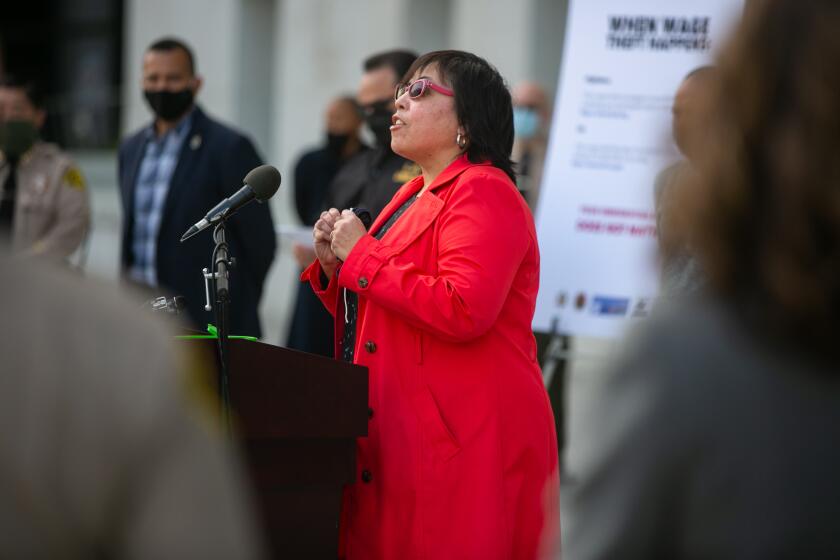15-Year Loans on Upswing : Shorter Home Payoff Time Proves Attractive
A growing number of home buyers are choosing 15-year mortgages over 30-year loans to save thousands of dollars in interest payments and build equity in their homes faster.
The 15-year mortgages and other types of “quick-pay” loans are also popular with homeowners who are refinancing older, high-interest loans. With today’s rates sharply lower than they were a few years ago, “many homeowners with a 30-year mortgage can refinance with a 15-year loan and their payment will fall or stay about the same,” says A. Gary Anderson, president of Directors Mortgage Loan Corp. in Riverside.
Lower rates also mean that the difference between monthly payments on a 15-year loan and a 30-year loan for the same amount is far less than it was when rates were higher.
As many as 16% of the mortgages being made today are 15-year loans, compared to less than 1% in 1980, according to the Mortgage Bankers Assn. of America. Home Federal Savings of San Diego reports that 25% of the home loans it is making are of the 15-year variety.
Paying off Mortgages Early
Many of the 15-year mortgages are being taken out by older people who want to pay their homes off before they retire, says Warren Lasko, executive vice president of the MBA.
The loans are also popular with high-income, younger couples who can afford higher monthly payments, or who want to pay off their loans before their children start college--a popularity that has led some bankers to dub the 15-year loans “yuppie mortgages.”
The biggest benefit of taking out a 15-year loan instead of a 30-year mortgage is the thousands of dollars the borrower saves in interest payments over the life of the loan. The savings stem from the faster payoff of the principal, plus the fact that rates on 15-year loans are usually about one-quarter of one percent lower than rates on 30-year mortgages.
For example, a borrower who takes out a 30-year, $100,000 loan at a 10% interest rate would pay $215,929 in interest charges over the life of the loan. But that same borrower would pay only $90,694 in interest expense if the loan was amortized over 15 years at 9 3/4%--a savings of $125,235.
Not for Everyone
Monthly principal and interest payments on the 15-year loan would total $1,059, compared to $878 on the 30-year loan.
“I think a lot of people are really surprised when they see how much money they’d save in interest payments” by taking out a 15-year loan instead of a 30-year mortgage, says Kevin Dunigan, Home Fed’s director of product management.
But 15-year loans aren’t for everyone. First-time home buyers usually choose a 30-year amortization schedule, Dunigan says, because the lower payments will be easier on what will probably be a strained budget. The smaller payments also make it easier to qualify for a loan.
Lenders sometimes require larger down-payments on 15-year loans than they do on 30-year mortgages. In addition, nimble investors may be able to take the $150 or so a month they’d save by taking out a 30-year loan and investing the money elsewhere.
Other Payment Methods
Several other types of loans are available to people who want to pay their loan off in less than 30 years.
A growing number of lenders are offering mortgages that call for payments to be made once every two weeks instead of once a month. Each biweekly payment is about half of what a monthly payment would be and results in a borrower making the equivalent of 13 monthly payments over the course of a year.
Homeowners who take out a loan with a biweekly mortgage payment plan typically own their home free and clear in about 18 years.
Another alternative is a “growing-equity mortgage.” A GEM allows the borrower to increase monthly payments a specified amount each year, typically about 5%. The additional amount is applied directly to the principal, which results in the loan being paid off in about 20 years.
But perhaps the most flexible way of paying a loan off early is to simply pay a little extra each month and tell the lender to apply it toward the principal. Some financial planners say that’s better than getting “locked in” to a strict repayment schedule that might be difficult to meet if the borrower gets into cash-flow problems.
Although most lenders allow borrowers to make larger-than-usual payments, Lasko at the Mortgage Bankers says few people have the willpower to do it. “A lot of people want the discipline of having to make the higher payments a 15-year repayment schedule demands,” Lasko says.
More to Read
Inside the business of entertainment
The Wide Shot brings you news, analysis and insights on everything from streaming wars to production — and what it all means for the future.
You may occasionally receive promotional content from the Los Angeles Times.










